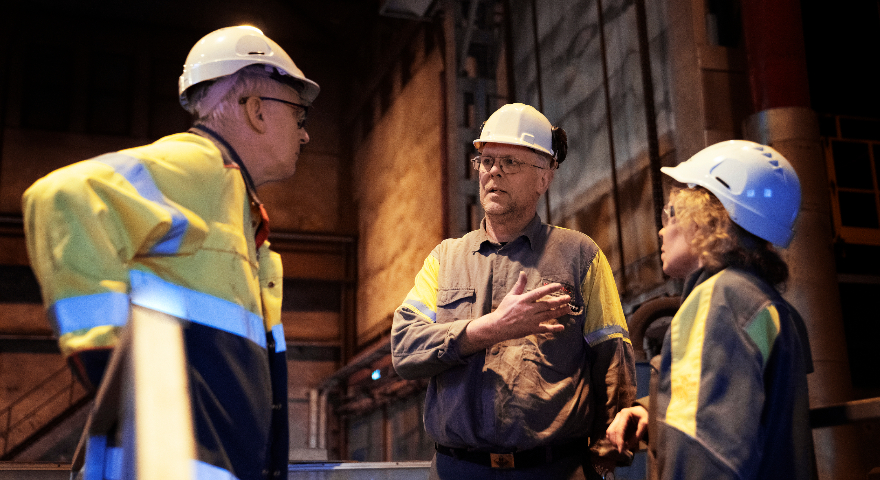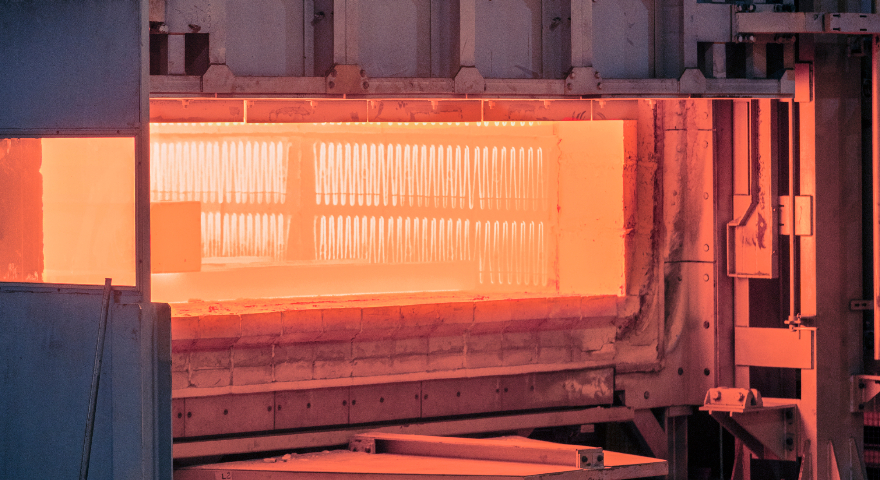Kanthal’s steel plant in Hallstahammar produces ingots of special Fe- and Ni-base alloys. The ingots are hot rolled into smaller billets and slabs in the ingot rolling mill. Before rolling, different ingot grades are heated to specific temperatures in the typical range 1,150-1,300 degrees Celsius (2,100-2,370 degrees Fahrenheit). This is traditionally made in large pit furnaces. These are heavy mass furnaces with limited temperature flexibility.
 Roger Berglund and Stephanie Stockmeier together with Peter Vabulis, Flow Manager at Kanthal's ingot rolling mill.
Roger Berglund and Stephanie Stockmeier together with Peter Vabulis, Flow Manager at Kanthal's ingot rolling mill.
Some ingots are sensitive to thermal shock and may crack if put directly into a hot pit furnace. There was a need for a furnace with higher temperature flexibility. Another need was ability to heat longer pieces of continuously casted materials. In 2012 Kanthal decided to build a car bottom furnace as a complementary ingot heating solution. It was decided to use a light weight thermal insulation and, of course, this had to be an electrically heated furnace.
“It was important to be able to heat the furnace up from room temperature to 1,250 degrees Celsius (2,280 degrees Fahrenheit) at a set rate,” explains Stephanie Stockmeier, Senior Process Development Engineer, Kanthal. “Some material we have to start heating from a low temperature in order to be able to roll them. So the ability to heat from 20 to 1,250 degrees in the same furnace, is a huge advantage.”
After purchasing a car bottom shell from a furnace manufacturer, Kanthal installed its Fibrothal® insulation and Kanthal® APM metallic heating elements. By choosing electric heating instead of gas, Kanthal has higher energy efficiency and better temperature control. With supply of fossil free electrical power this furnace is basically operating without CO2 emissions.
 The car bottom furnace with electric Fibrothal® heating modules at Kanthal's ingot rolling mill.
The car bottom furnace with electric Fibrothal® heating modules at Kanthal's ingot rolling mill.
A faster and more reliable process
“It’s a faster process,” says Stockmeier. “We can start the furnace at room temperature and gradually heat our ingots to above 1,200 degrees Celsius for rolling the next day, and then go back to room temperature the following day. The elements are so reliable that they will last even if you start at 20 and go to 1,200 degrees Celsius.”
Due to its low thermal mass, the Fibrothal® insulation also helps to maintain good temperature control with minimal energy loss.
“With the light weight insulation we minimize the required energy input every time we heat up the furnace, and the same goes for when we have to cool it down,” says Roger Berglund, Senior Expert at R&D, Kanthal. “The furnace gets faster and easier to control, which is the good thing about fiber insulation.”
